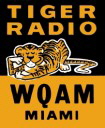|
One of the big fads of the 1920s was the radio verification stamp. With a letter to a station about their programs and a dime, a listener could get a handsome stamp with the station’s call sign, made for the EKKO Company. The EKKO Company made an album to put the stamps in, and the hobby blossomed into a craze in 1924. For an excellent guide to EKKO stamps by czelbst, go here.
Radio verification stamps fall into three categories: EKKO stamps, Bryant stamps and stamps produced for individual stations. Most EKKOs are relatively common, as are many of the individual stamps (though a few are quite rare). Bryants, on the other hand, are uncommon. Here’s why.
EKKO stamps were selling like hotcakes in 1925 when the PM Bryant Company decided to compete with the EKKO Company. Bryant, based in the Wrigley Building in Chicago, decided to issue its own stamps and stamp album. Bryant's stamps and first album appeared September, 1925. The Bryant stamp was smaller then the EKKO version, and required only two print passes to manufacture (EKKOs required three). The second pass, when the call sign was applied, was sequential (WBAA, then WBAB, then WBAC, etc.), which meant that the blanks remained in the press, and printing was more efficient. The stamp album for Bryants was smaller and less expensive to produce as well. Those advantages were offset by the fact that the EKKO Company already had radio stations giving out their stamps. Although there is some limited evidence that a few smaller stations gave out Bryant stamps, most if not all Bryants were purchased directly from the Bryant Company. This may be one of the reasons the EKKO Company decided to sell directly to the public as well.
The EKKO Company decision apparently spelled doom for the Bryant Company. They issued at least two different albums and just under 600 different stamps, but were gone before 1927.
|

